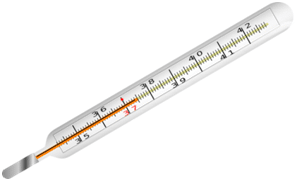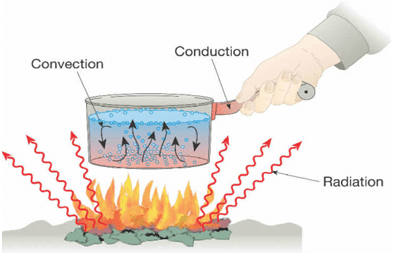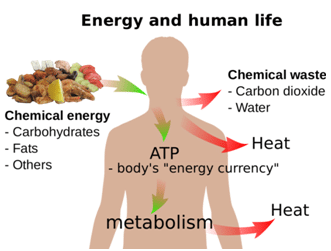Heat Technology
Grade 7 Science Worksheets
What is the meaning of heat in physics?
Heat energy is the movement of atoms or molecules in various states of matter from one object to another object that are in different temperatures.
What is the science of heat?
- energy is transferred from the object with the higher temperature to the object that has the low er temperature.
- The form of energy being transferred is thermal energy.
What is an example of heat?
Around us, we see that most popular example of heat is the Sun, which radiates heat to warm up the earth.
A burning candle is a source of heat energy.
Thermal energy is particles in a substance that are kinetically charged.

Temperature
It is not how hot or cold something is.
- Hot and cold are relative.
- Temperature is a measure of the average kinetic energy of the particles in an object.
- All matter is made of particles that are constantly moving.
- The more the particles move, the more kinetic energy, therefore, higher temperature.
How do we measure temperature?
- Thermometer: Thermometer measures temperature due to thermal expansion.
- Thermal expansion is an increase in the size of a substance due to its increase in the temperature.
- As a substance’s temperature increases, its particles move faster and spread out. There is more space between them making it expand.
Ways to transfer thermal energy
- Conduction
- Convection
- Radiation

Credit: http://efdreams.com/data_images/dreams/thermometer/thermometer-07.jpg
Conduction
- Thermal conduction is the transfer of thermal energy from one substance to another through direct contact.
- Substances that have a tendency to conduct thermal energy well are called good conductors. Example: iron, copper.
- Substances that do not conduct thermal energy well are called bad conductors or insulators
Example: wood, plastic, rubber
Convection
Convection is the transfer of thermal energy by the circulation or movement of a liquid or gas.
Radiation
Radiation is the transfer of energy as electromagnetic waves.

credit: https://www.thinglink.com/scene/634810644025049090
States of Matter
- States of matter are the physical forms of matter, which include solid, liquid and gas.
- A change of state is a change of a substance from one physical state to another.
Changes
Heat can be involved in both physical changes (change of state) and chemical changes.
Food and Chemical Energy
- Energy that our body can use is released when chemical compounds such as carbohydrates are broken down.
- Energy is released in chemical reactions.
By looking at the calories on the nutrition label we get to know how much chemical energy is present in a particular food.
- The calorie is the unit of energy in food = a measure of heat.
1 calorie = 4184 J
Calorimeter
A calorimeter is a device that measures heat.

Credit:https://in.pinterest.com/pin/322851867014468505/
Learn more about Heat Technology and other important topics with 7th Grade Science Tutoring at eTutorWorld. Our expert science tutors break down the topics through interactive one-to-one sessions. We also offer the advantage of customized lesson plans, flexible schedules and convenience of learning from home.
Schedule a Free session to clear worksheet doubts
No credit card required, no obligation to purchase.
Just schedule a FREE Sessions to meet a tutor and get help on any topic you want!
Check Point
A. Fill in the blanks
- …………………… is the energy transferred between objects that are in different temperatures.
- Energy moves from the object with the ……………… temperature to the object that has the …………..temperature.
- …………….. energy is particles in a substance that are kinetically charged
- Thermometers can measure temperature due to …………………………………..
- Radiation is the transfer of energy as ……………………… waves.
B. State True or False
- Thermal conduction is the transfer of heat energy by the process of collision of atomic particles from one substance to another through direct contact.
- Temperature is a measure of the average potential energy of the particles in an object.
- Thermal expansion is an increase in the size of a substance in response to a decrease in the temperature of the substance.
- Energy that our body can use is released when chemical compounds such as carbohydrates are broken down.
- Convection is the transfer of heat by the mostly in liquids and gases by circling motion.
Answer Key
A. Fill in the blanks
- Heat
- Higher , lower
- Thermal
- Thermal expansion
- Electromagnetic waves
B.State True or False
- True
- False
- False
- True
- True
Learn more about Scientific Method and other important topics with 7th Grade Science Tutoring at eTutorWorld. Our expert science tutors break down the topics through interactive one-to-one sessions. We also offer the advantage of customized lesson plans, flexible schedules and convenience of learning from home.
Pricing for Online Tutoring
| Tutoring Package | Validity | Grade (1-12), College |
|---|---|---|
| 5 sessions | 1 Month | $124 |
| 1 session | 1 Month | $25 |
| 10 sessions | 3 months | $239 |
| 15 sessions | 3 months | $354 |
| 20 sessions | 4 months | $449 |
| 50 sessions | 6 months | $1049 |
| 100 sessions | 12 months | $2049 |
6th Grade Free Worksheets
- Elements & Compounds
- Solar Energy
- Photosynthesis
- Digestive System
- Electricity and Magnetism
- Law of conservation of energy
- Law of Conservation of Mass
- Periodic table
- Properties of Matter
- Waves
- Energy Resources
- Weather and Climate
- Immune, Circulatory and Digestive Systems
- Organs in Multi-cellular Organisms
- Sedimentary, Igneous, and Metamorphic Rocks
- Structure of the Earth
- Physical and Chemical Changes
- Scientific Method
- Cycles in Nature
- Environmental Science
- Renewable and Non-renewable energy Resources
- Characteristics of Living Organisms
- Life Science
- Earth and Space Science
- Solar Eclipse
- Heat Technology
- Newton’s Laws of Motions
- Physical Science
- Tools, Measurement and SI Units
- Earth Atmosphere
- Interactions of Living things
- The Earth Ecosystem
- Organelles in Plant and Animal cells
- Layers of the Earth


